Sergeant Charles (Chuck) Page's Wartime Story
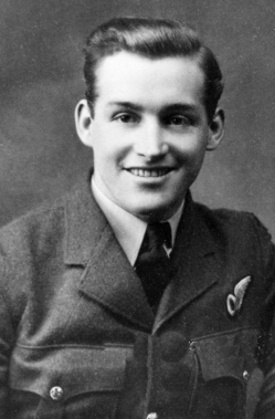
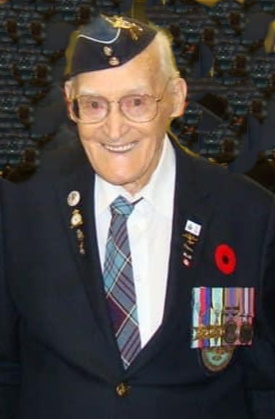
Charles Richard Page was born in St, Catharines, Ontario to Herbert James and Ann Nolan Page on August 9, 1920 - born a Leo and still roaring at the age of 100. Here is the story of his experiences during WW2.
Charles (Chuck) Page joined the RCAF at Hamilton, Ontario in July 1941. He was sworn in and sent home on leave for two weeks before reporting to No. 1 Manning Depot, Toronto and to attend the Initial Training School (ITS) at Belleville, Ontario. On completion of the ITS and after some leave, he was off to the Air Observer School at Jarvis, Ontario. Eight weeks later he graduated and continued to the Bombing and Gunnery school at St. Jean, Quebec for a further six weeks of training. Next he attended Navigation school for Navigator-Bomb Aimers. Chuck received his wings in April, 1942.
Before catching the train to Halifax for transport to England, Chuck was given two weeks leave to say goodbye to his family in St. Catharines. They did not tell him that his mother was gravely ill though looking back he recalled that she did not look well during his visit. The family did not want to burden him with worry as he was embarking on his war service. His father, mother and sister Dot accompanied him to the train station for their final goodbyes.
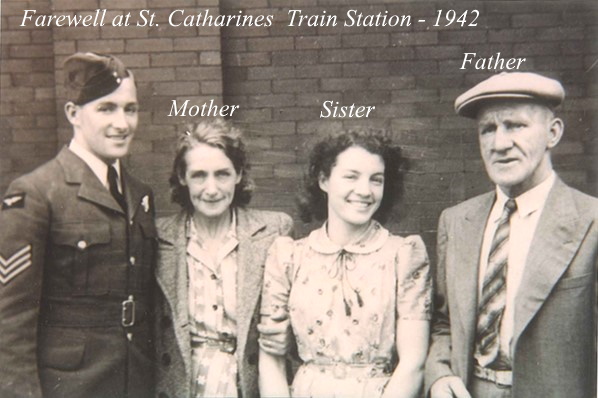
Chuck's mother Ann would pass away on November 11, 1943 while Chuck was in POW camp. He received a letter from his father which arrived around February, 1944 while he was still at Hydekrug. To this day November 11 has a double significance to Sergeant Page.
Upon arrival in Halifax he and his mates found themselves at leisure for a few weeks before the Empress of Australia arrived to ferry them to England. Chuck estimated 6,000 troops were on the Empress crossing with many other troop ships in their convoy. Fortunately the convoy met no submarines. Chuck's older brother Al had already enlisted the Army and was already in Europe flying spotter planes for Artillary.
Arriving in Liverpool in September 1942 after six days at sea, aircrew service personnel were immediately shipped to Bournemouth, the receiving center for arriving Canadian aircrew. After processing and induction, which could take months, they were melded into crews and assigned a squadron.
Chuck's new crew with pilot P/O Gagnon were moved to Croft to join 427 Squadron which was being trained on Wellingtons. In December 1942, several attempts were made for mining operations from Middleton St. George before being scrubbed. On December 14 three aircraft of 427 Squadron were sent to Middleton St. George to be loaded since no mines were available at Croft. Of the three aircraft on the operation two returned with their mines since they could not pin-point their position. The P/O Gagnon crew of which Chuck Page was the navigator-bomb aimer was successful.
On mining operations a 500lb mine was utilized. To drop it the aircraft had to start out at a specific landmark, drop down to 300 feet above ground, hold the course and speed steady and after a pre-determind time drop the mine. P/O Gagnon's operation was a success and they were the first 427 crew to complete an operation.
427 Squadron became operational in January 1942 and became part of 6 Group in Bomber Command. The squadron continued with mining operations and as well were assigned bombing operations into Germany.
On May 1, 1943, 427 Squadron began the move to Leeming and at the same time transitioning to the Halifax aircraft. The month of May was taken up with training on the Halifax. It was a tight squeeze for the seven crew members onboard the four engine Halifax especially at the front of the aircraft.
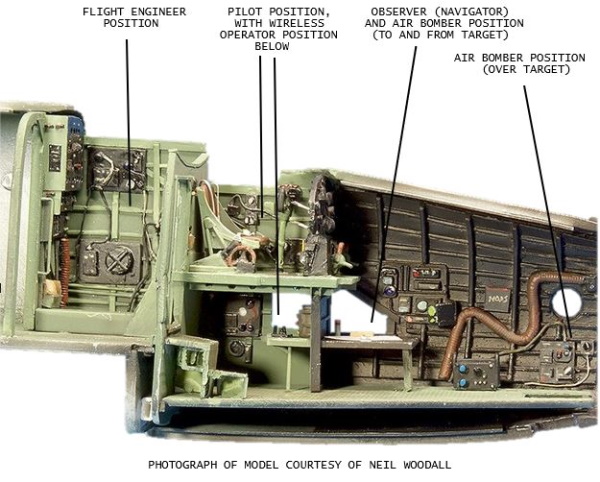
Thanks to Pete Tresadern of the RAF 35 Squadron website and Neil Woodall on the the BritModeller.com website
On May 28 the squadron became operational again and the next day were tasked with their first operation with Halifax aircraft to bomb Wuppertal. Report of the aircraft damage received on the Wuppertal operation by Chuck Page's crew The next 27 days were very busy with Chuck's crew completing a further eighteen operations. On June 25/26, 1943 Chuck's crew were tasked to be part of a night bombing operation to Gelsenkirchen in the Ruhr.
Crew Members
Pilot - Pilot Officer Gerald Alban Gagnon, RCAF (J/17025)
Navigator - Flying Officer R.J. Frost, RCAF (J/13420)
Bomb Aimer - Sergeant Charles Richard Page, RCAF (R/114415)
Wireless Operator/Air Gunner - Sergeant John Richard Hooley, RCAF (R/108426)
Air Gunner - Sergeant Angus Anthony McKinnon, RCAF (R/104179)
Air Gunner - Sergeant Clarence Ray Munson, RCAF (R/116469)
Flight Engineer - Sergeant K.A. Shannon, RAF (623715)
This was to be Bomb Aimer Sgt. Page's nineteenth and final operation. His flight crew and its aircraft were one of the nine aircraft from 427 squadron assigned to this forty two aircraft operation. One 427 aircraft was scrubbed before take off due to a malfunction. A second piloted by the Commanding Officer, W/C Burnside crashed on takeoff due in part to a loss of brake pressure. Fortunately, Burnside's crew survived with no serious injuries. Sadly, of the seven aircraft that continued on the operation only five returned to Croft. The aircraft piloted by Flight Sergeant Higgins and P/O Gagnon did not return.
Chuck Page remembers the night of June 25 very well. His crew had a few false starts to its operation. Their original Halifax aircraft was in for a major overhaul so they were flying in a different aircaft whose rear radar, nicknamed "monica", was not working. In addition, during the takeoff the overhead pilot escape hatch flipped open requiring Chuck and the Flight Engineer to reach up, pull it down and relatch it. The crew of seven continued on to their target Gelsenkirchen. They successfully dropped their bombs on the target and set a course for home. However, a miscommunication with the Navigator, resulted in their flying off course. They were separated from the other aircraft on the operation and found themselves flying alone along the coast of Holland. Regrettably Page's aircraft was picked up by a German night fighter, piloted by a Captain Jabs of the Luftwaffe. Their Halifax was badly damaged with two engines failed and aircraft control degraded. P/O Gagnon ordered the crew to bail out.
Sergeant Page rushed to the rear of the plane where he was aware that Air Gunner Munson had been shot in the ankle. Page left him to find oxygen and assistance to help with Munson. When he returned less than a minute later Munson had already bailed out. Page fought his way back to the front of the plane as it began to descend. All the other crew were gone. Page grabbed his chute and jumped out, the last to exit the Halifax, DK180.
All survived their landings except P/O Gagnon who died after landing and Ray Munson who was seriously injured, initially in the aircraft, but definitely by the time he found himself on the ground...he could not walk and had to crawl to a Dutch family's house. The family sent for a local Doctor who determined that Ray's injuries were likely life threatening or at least limb threatening and he ended up being hospitalized for quite a while. While he was in the hospital he was indentified by the Germans and made a POW after he had healed.
At the time, the crew believed pilot Gagnon had been killed in the plane by flak. It wasn't until many years later Chuck learned that his pilot had more likely drowned in a canal after landing and wished he had somehow been able to save him. He remembers Gagnon as a very fine young man.
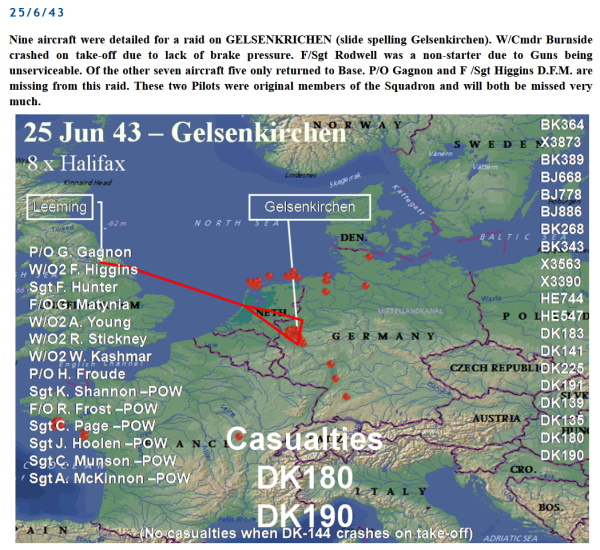
Finding himself alone in a farmer's field, Chuck concealed his parachute in the hay and hid along the bank of a nearby canal. He had a lonely moment of reflection, thinking of his mother and how the news would impact her, not knowing that he had survived the crash. Chuck used the silk map in his escape kit to determine his location which was near the town of Alkmaar, North Holland. He began traveling south at nighttime but was soon spotted by two Dutch policmen on their bicycles as he was crossing a road. He was arrested and taken to the nearest Gestapo hesdquarters. The rest of the crew were quickly captured with the exception of Sgt. Ray Munson.(see above) Meanwhile, after an initial interrogation, Chuck and the rest of the crew were taken to Amsterdam, then Frankfurt where the real interrogation took place. They were finally shipped to Stalag Luft VI a Luftwaffe administered camp in East Prussia.
Camp life for Sgt. Page consisted of daily roll call, rough barrack accomodation and a diet of potatoes, black bread and cabbage soup. He remembers fondly the arrival of Red Cross packages. Chuck maintains that the Canadian parcels were the best with their rations of butter, coffee, chocolate, jam and powdered milk (KLIM). Some of his fellow POWs managed to secret a radio in their barracks so news of the war could get through from England. Some men regularly plotted to escape. They devised a means to dig a long tunnel with entrance below a barracks stove and exit on the opposite side of the barbed wire fence. They would dig at night and hide dirt in their pockets which they distributed around the exercise grounds during the day. Unfortunately, the length of the tunnel did not extend into the trees outside the camp as planned. After about twenty five men escaped and ran for the trees one was spotted by the guard patrolling the boardwalk. Many men were trapped behind him in the tunnel and those in barracks were forced to reveal the entrance under the stove so all could be removed. Chuck remembers the Germans were not happy about these attempts and increased their barracks searches after that. At least one man was executed.
There were five or six thousand allied POWs housed in the camps in this area. Page recalls that the Russian prisoners who were housed separately received much rougher treatment. They wandered the fence perimeter in rags, eating what scraps they could find and doing menial tasks for the Germans.
In March 1944, word began to circulate that the Russian army was making its way south from the Baltic states and into East Prussia. As a result, in April, Chuck and his fellow prisoners were moved in crowded railway boxcars to Torum in Poland. From there they were once more loaded into railroad cattle cars and several days later arrived at Fallingbostel, a camp sixty kilometers south of Hamburg.
They remained at Fallingbostel from August 1944 to April 1945. The Red Cross packages stopped arriving as the war neared the end. In April 1945, the Germans decided to move the prisoners once again but this time they marched across Germany trying to evade the Russians pushing from the North and East and the Allies from the South and West. After five days of marching they stopped overnight and Chuck with two companions decided it was time to escape. The guards at this time were less than vigilant since they were aware of the impending end of the war. Chuck and his two companions, one of whom was Ken Shannon, the Flight Engineer from his crew escaped heading west, traveling at night time only. After six days they ran into units of the British 8th Army and freedom.
In London they were outfitted again, received part of their back pay and allowed a few weeks leave. At this time Chuck was pleased to be reunited with his brother Captain Al Page and they stayed with an Aunt in Edinburgh until their leave was finished.
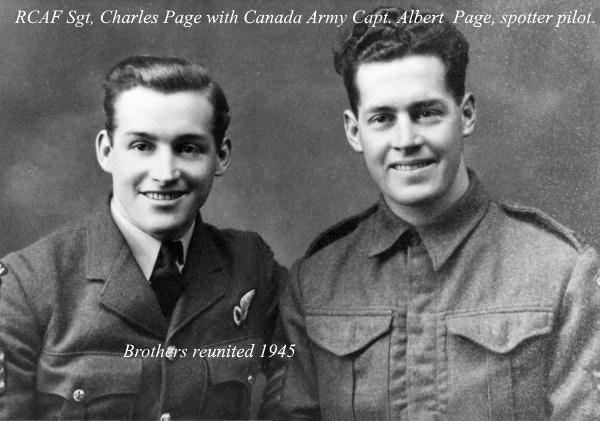
Then Chuck and Al headed back to London prepared to receive orders to be shipped home. Chuck soon received his vouchers for travel and left London for Gourock, Scotland and embarkation on the Ile de France. He waited days on the ship while troops were being boarded. One day he noticed some new arrivals with the insignia of Al's Army unit. He asked if anyone knew Al Page. The answer was "Yep he's right over there" as Al boarded the ship. They sailed home together. By a lucky coincidence his brother Al had been assigned to the same ship.
There was a mirror-like calm on the Atlantic as they made their way back to Halifax. An apt end to a tumultuous period.
Back in Canada, Page made a point of visiting the mother of pilot Gerald Gagnon as he grieved the loss of his own mother. War claims many victims as all veterans know.
Many thanks to Nancy DeVuono, Rick Page and David Page for much advice, editing and information. Also Ken Sorfleet, the 427 Squadron Association Facebook Manager, for many useful comments and corrections.
The link below is for a Vimeo video. These videos are part of a government sponsored project to capture veterans' experiences. The project includes veterans' stories from WW II to the present. The link below is to Chuck Page's story in his own words.
https://vimeo.com/channels/theveterans/17495905
A YouTube Video - Coverage of Chuck's Challenge
Goto Chuck's Challenge
Chuck Page's Photo Album


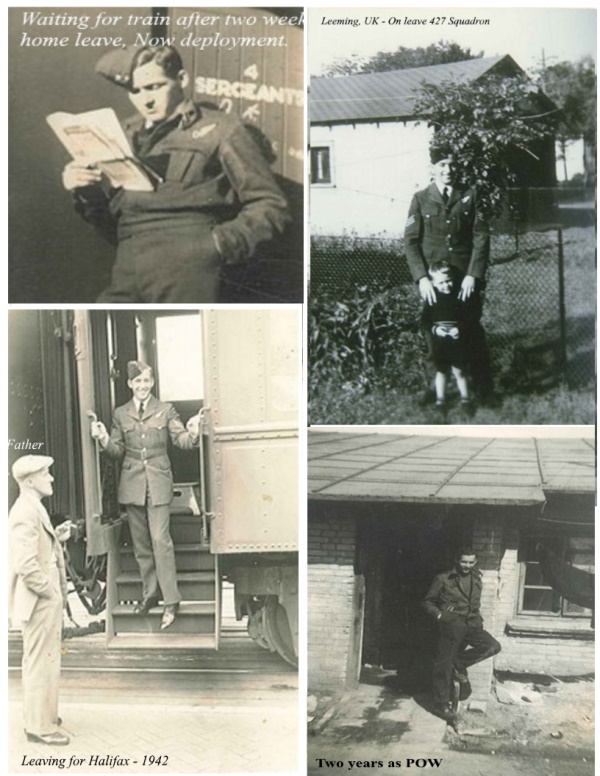
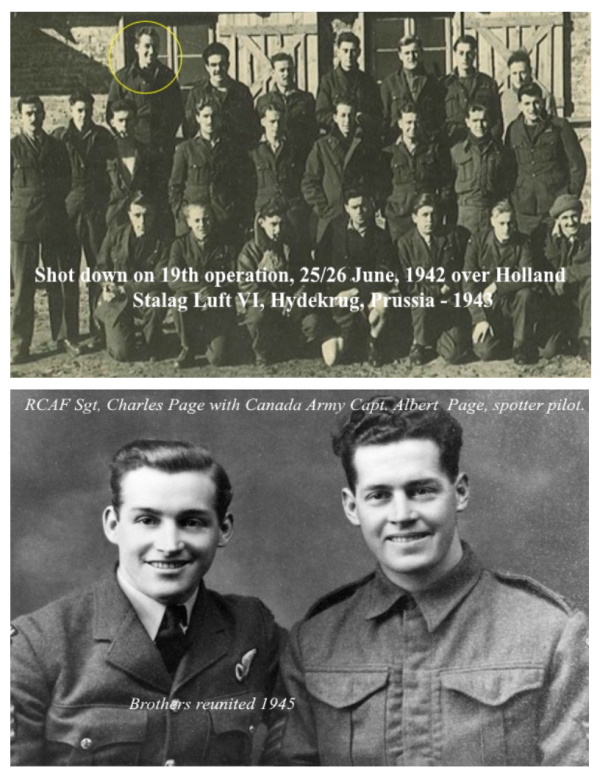
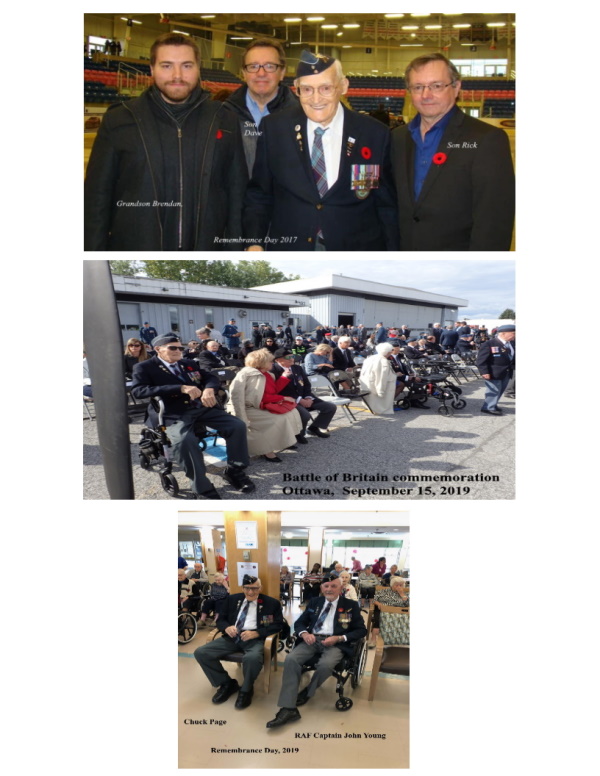
Remember to access the Facebook page as Ken Sorfleet has additional and related information posted. Links to that information are embedded in the narrative above.
Report on a POW Long March WW II